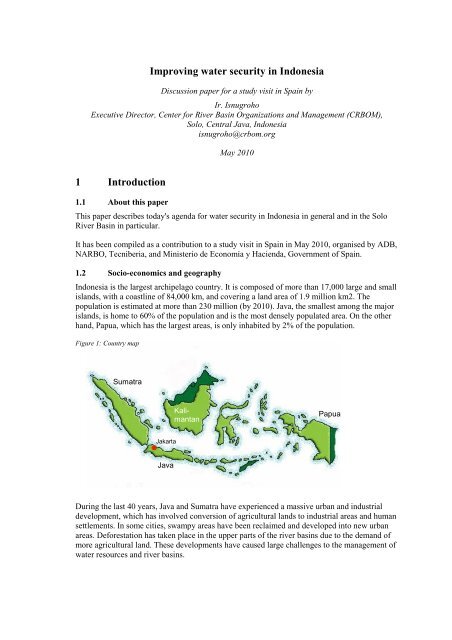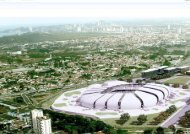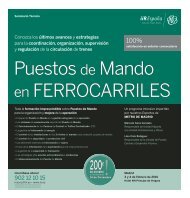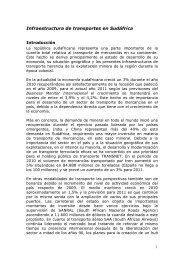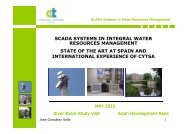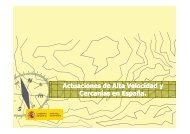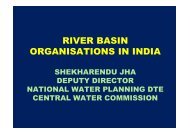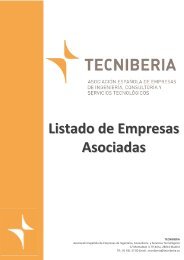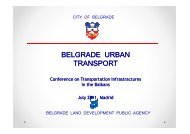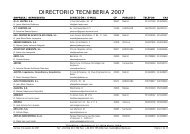Improving water security in Indonesia 1 Introduction - Tecniberia
Improving water security in Indonesia 1 Introduction - Tecniberia
Improving water security in Indonesia 1 Introduction - Tecniberia
Create successful ePaper yourself
Turn your PDF publications into a flip-book with our unique Google optimized e-Paper software.
<strong>Improv<strong>in</strong>g</strong> <strong>water</strong> <strong>security</strong> <strong>in</strong> <strong>Indonesia</strong><br />
Discussion paper for a study visit <strong>in</strong> Spa<strong>in</strong> by<br />
Ir. Isnugroho<br />
Executive Director, Center for River Bas<strong>in</strong> Organizations and Management (CRBOM),<br />
Solo, Central Java, <strong>Indonesia</strong><br />
isnugroho@crbom.org<br />
1 <strong>Introduction</strong><br />
1.1 About this paper<br />
May 2010<br />
This paper describes today's agenda for <strong>water</strong> <strong>security</strong> <strong>in</strong> <strong>Indonesia</strong> <strong>in</strong> general and <strong>in</strong> the Solo<br />
River Bas<strong>in</strong> <strong>in</strong> particular.<br />
It has been compiled as a contribution to a study visit <strong>in</strong> Spa<strong>in</strong> <strong>in</strong> May 2010, organised by ADB,<br />
NARBO, <strong>Tecniberia</strong>, and M<strong>in</strong>isterio de Economía y Hacienda, Government of Spa<strong>in</strong>.<br />
1.2 Socio-economics and geography<br />
<strong>Indonesia</strong> is the largest archipelago country. It is composed of more than 17,000 large and small<br />
islands, with a coastl<strong>in</strong>e of 84,000 km, and cover<strong>in</strong>g a land area of 1.9 million km2. The<br />
population is estimated at more than 230 million (by 2010). Java, the smallest among the major<br />
islands, is home to 60% of the population and is the most densely populated area. On the other<br />
hand, Papua, which has the largest areas, is only <strong>in</strong>habited by 2% of the population.<br />
Figure 1: Country map<br />
Sumatra<br />
Jakarta<br />
Java<br />
Kali-<br />
mantan<br />
Papua<br />
Dur<strong>in</strong>g the last 40 years, Java and Sumatra have experienced a massive urban and <strong>in</strong>dustrial<br />
development, which has <strong>in</strong>volved conversion of agricultural lands to <strong>in</strong>dustrial areas and human<br />
settlements. In some cities, swampy areas have been reclaimed and developed <strong>in</strong>to new urban<br />
areas. Deforestation has taken place <strong>in</strong> the upper parts of the river bas<strong>in</strong>s due to the demand of<br />
more agricultural land. These developments have caused large challenges to the management of<br />
<strong>water</strong> resources and river bas<strong>in</strong>s.
1.3 River bas<strong>in</strong> management<br />
In <strong>Indonesia</strong>, a dist<strong>in</strong>ction is made between 5 types of river bas<strong>in</strong>s:<br />
a. International river bas<strong>in</strong>s: 5<br />
b. Inter-prov<strong>in</strong>ce river bas<strong>in</strong>s: 27<br />
c. Strategic river bas<strong>in</strong>s: 37<br />
d. Inter-regency/city river bas<strong>in</strong>s: 51<br />
e. Regency/city river bas<strong>in</strong>s: 13<br />
The country has several types of river bas<strong>in</strong> organizations (RBOs), as follows:<br />
Public corporate RBO (Perum Jasa Tirta, PJT)<br />
In developed and strategic bas<strong>in</strong>s of national importance, the government has established selff<strong>in</strong>anc<strong>in</strong>g,<br />
autonomous river bas<strong>in</strong> management corporations. Two river bas<strong>in</strong> authorities of this<br />
type have been created: the Jasa Tirta I Public Corporation <strong>in</strong> the Brantas and Bengawan Solo<br />
River Bas<strong>in</strong> (Perum Jasa Tirta I) and the Jasa Tirta II Public Corporation (Perum Jasa Tirta II)<br />
cover<strong>in</strong>g the Citarum River (part of the greater Citarum Bas<strong>in</strong>). They are responsible for <strong>water</strong><br />
allocation and for operation of <strong>water</strong>-related <strong>in</strong>frastructure. They are owned and governed by the<br />
State (M<strong>in</strong>istry of Public Works). They operate on a commercial basis and recover some (but<br />
not all) of their costs.<br />
The social functions of the PJTs are:<br />
- Conservation and susta<strong>in</strong>ability of <strong>water</strong> resources;<br />
- supply of <strong>in</strong>formation and recommendations on <strong>water</strong> resources management <strong>in</strong> the bas<strong>in</strong>;<br />
- allocation of <strong>water</strong> for various uses;<br />
- flood and drought management; and<br />
- <strong>water</strong> quality management.<br />
The commercial functions of the PJTs are:<br />
- Supply of raw <strong>water</strong> for domestic and municipal <strong>in</strong>dustrial uses;<br />
- allocation of <strong>water</strong> for agriculture and <strong>in</strong>dustries;<br />
- allocation of <strong>water</strong> for hydropower generation;<br />
- other services, related to tourism, <strong>water</strong> quality monitor<strong>in</strong>g, technical assistance, capacitybuild<strong>in</strong>g,<br />
etc.<br />
Central government RBO (Balai Besar Wilayah Sungai, BBWS/Balai Wilayah<br />
Sungai, BWS)<br />
The central government 3 has established 12 Balai Besar Wilayah Sungai (BBWS) and 19 Balai<br />
Wilayah Sungai (BWS) to manage <strong>water</strong> resources <strong>in</strong> 67 particular bas<strong>in</strong>s. The management is<br />
1 M<strong>in</strong>istry of Public Work Regulation No. 11/ A/ PRT/ M/ 2006 regard<strong>in</strong>g Criteria and Declaration on River<br />
Bas<strong>in</strong>s<br />
2 Or '<strong>water</strong> management districts', 'Satuan Wilayah Sungai', SWS, that <strong>in</strong>clude some adjacent areas that dra<strong>in</strong><br />
directly to the sea<br />
3 M<strong>in</strong>istry of Public Works Decree No. 12/PRT/M/2006<br />
1 2<br />
2
not only limited to operation and ma<strong>in</strong>tenance but also covers river bas<strong>in</strong> plann<strong>in</strong>g and<br />
development. The tasks and responsibilities of the BWS/BBWS are based on the Water<br />
Resources Law No. 7 / 2004, which covers <strong>water</strong> resources conservation, utilization, and<br />
prevention of <strong>water</strong>-related hazards. These organisations are fully funded by the central<br />
government. There is no cost recovery at present, but it is planned to collect fees from<br />
commercial beneficiaries.<br />
Prov<strong>in</strong>cial government RBO (Balai PSDA)<br />
At the prov<strong>in</strong>ce level, the local governments can set up permanent Bas<strong>in</strong> Management Units<br />
(Balai PSDA) to implement <strong>water</strong> resources management at the bas<strong>in</strong> level. The Balai PSDA is<br />
placed under the Prov<strong>in</strong>cial Public Water Resources Service(D<strong>in</strong>as PSDA). Their roles, and<br />
responsibilities cover <strong>water</strong> allocation for several users, management of rivers, reservoirs, lakes<br />
and ponds, flood control and drought management, swamps, <strong>in</strong>-stream pollution control, river<br />
mouth ma<strong>in</strong>tenance, and <strong>in</strong>ter-district irrigation systems. They are funded by the prov<strong>in</strong>cial<br />
government budget (which is limited). Among the 33 prov<strong>in</strong>ces <strong>in</strong> <strong>Indonesia</strong>, only 15 have<br />
bas<strong>in</strong> management units, with a total number of 59 such units.<br />
Prov<strong>in</strong>ce/regency/municipal <strong>water</strong> resources services 4<br />
Such units have been established under prov<strong>in</strong>ce/regency/municipal government regulation.<br />
Their tasks and responsibilities are ma<strong>in</strong>ly operation and ma<strong>in</strong>tenance of small rivers and<br />
irrigation systems under 1,000 ha. A prom<strong>in</strong>ent problem is limited budgets.<br />
--------------<br />
Between them, the different bodies cover the follow<strong>in</strong>g areas:<br />
• 3 river bas<strong>in</strong>s are managed by the Corporate Type RBOs (PJT-I for Brantas River Bas<strong>in</strong><br />
and Bengawan Solo River Bas<strong>in</strong> and PJT-II for Citarum River Bas<strong>in</strong>);<br />
• 67 river bas<strong>in</strong>s are managed by central government RBOs (17 bas<strong>in</strong>s are managed by 12<br />
BBWS and 50 bas<strong>in</strong>s are managed by 19 BWS);<br />
• 15 river bas<strong>in</strong>s are managed by prov<strong>in</strong>cial government RBOs, and various units of<br />
regency/city task forces are <strong>in</strong>volved <strong>in</strong> manag<strong>in</strong>g river bas<strong>in</strong>s, particularly with<strong>in</strong> a<br />
regency or city.<br />
Some of the <strong>water</strong> resources problems <strong>in</strong> a river bas<strong>in</strong> are related to the capacity of the RBOs<br />
and their authority <strong>in</strong> law enforcement. Examples are deforestation, bad agricultural practices,<br />
land use changes, reclamation of swampy areas, encroachment of river channels, etc. Such<br />
challenges require authority and human resources. Therefore, capacity-build<strong>in</strong>g of RBOs is a<br />
critical task <strong>in</strong> the future.<br />
4 <strong>Indonesia</strong> has 33 prov<strong>in</strong>ces (<strong>in</strong>clud<strong>in</strong>g 2 special regions and 1 special capital city district); 397 regencies;<br />
and 98 municipalities<br />
3
2 <strong>Improv<strong>in</strong>g</strong> <strong>water</strong> <strong>security</strong><br />
2.1 Flood management and climate proof<strong>in</strong>g 5<br />
From 1985 to 2009, there were 154 flood events <strong>in</strong> <strong>Indonesia</strong> - more than 6 per year - and<br />
clearly escalat<strong>in</strong>g over the period. 54 of these floods were classified as severe; and more than 40<br />
of the floods occurred <strong>in</strong> Java. There were severe floods <strong>in</strong> Jakarta <strong>in</strong> early 2007; and <strong>in</strong> the<br />
Bengawan Solo Bas<strong>in</strong> <strong>in</strong> December 2007/January 2008, and aga<strong>in</strong> <strong>in</strong> early 2009.<br />
Box 1: Climate proof<strong>in</strong>g <strong>in</strong> Java<br />
Java is exposed to a number of factors that affect the flood risk and flood vulnerability, such as (<strong>in</strong> random order):<br />
El Niño (mesoscale) climate oscillations; global climate change; volcanic eruptions and earthquakes; changed land<br />
use; land subsidence related to ground<strong>water</strong> abstraction; sand m<strong>in</strong><strong>in</strong>g; river regulation; and general development of<br />
the physical <strong>in</strong>frastructure. With land slides as a related calamity, serious (and apparently escalat<strong>in</strong>g) consequences<br />
to human lives, crops, properties and <strong>in</strong>frastructure have occurred <strong>in</strong> recent years.<br />
Flood proof<strong>in</strong>g measures are <strong>in</strong> progress or are be<strong>in</strong>g planned at the national, prov<strong>in</strong>ce, regency/municipality and<br />
community level of adm<strong>in</strong>istration. They <strong>in</strong>clude flood storage capacity; dykes; flood channels; dra<strong>in</strong>age (flow)<br />
capacity ma<strong>in</strong>tenance and enhancement; land conservation <strong>in</strong> head<strong>water</strong> areas; erosion control (terrac<strong>in</strong>g, regreen<strong>in</strong>g,<br />
reforestation and sediment control); flood hazard mapp<strong>in</strong>g; public awareness; and forecast<strong>in</strong>g and<br />
operational warn<strong>in</strong>g.<br />
Source: Fahmi Hidayat (Oct 09)<br />
Figure 2: Location of the Solo River Bas<strong>in</strong><br />
Jakarta<br />
0 200 km<br />
2.2 Land subsidence<br />
Land subsidence is observed <strong>in</strong> several major Javanese towns, <strong>in</strong>clud<strong>in</strong>g Jakarta, where the rate<br />
is up to 10-12 cm/year <strong>in</strong> places. This is due to a comb<strong>in</strong>ation of natural causes and ground<strong>water</strong><br />
abstraction. The subsidence will <strong>in</strong>teract adversely with a ris<strong>in</strong>g sea level.<br />
2.3 Sediment control<br />
Bandung<br />
Java<br />
Sedimentation takes place <strong>in</strong> rivers and reservoirs, partly for natural reasons and partly due to<br />
changed land use. The sedimentation <strong>in</strong>creases the flow resistance of flow channels, hereby<br />
add<strong>in</strong>g to the flood risk, and reduces the precious live storage capacity <strong>in</strong> reservoirs.<br />
5 Section quoted from Fahmi (Oct 09)<br />
Yogyakarta Solo<br />
Surabaya<br />
4
Figure 3: Ma<strong>in</strong>tenance dredg<strong>in</strong>g <strong>in</strong> the Wonogiri Reservoir, Solo River Bas<strong>in</strong><br />
A variety of mitigation measures are be<strong>in</strong>g implemented, <strong>in</strong>clud<strong>in</strong>g control of land use,<br />
alternative rout<strong>in</strong>g of flows with high sediment loads, and dredg<strong>in</strong>g <strong>in</strong> reservoirs.<br />
2.4 Waste<strong>water</strong> disposal<br />
Orderly disposal of waste<strong>water</strong> is an escalat<strong>in</strong>g challenge, due to the general economic<br />
development, urbanization, <strong>in</strong>creased demand of <strong>water</strong>, and <strong>in</strong>creased waste production from<br />
households and <strong>in</strong>dustries.<br />
3 River bas<strong>in</strong> governance<br />
3.1 Prospects for bas<strong>in</strong>-level management<br />
<strong>Indonesia</strong> has a long history <strong>in</strong> develop<strong>in</strong>g river bas<strong>in</strong> organizations. A large variety of<br />
challenges from one river bas<strong>in</strong> to another is reflected by different approaches and <strong>in</strong>stitutional<br />
arrangements. Some river bas<strong>in</strong>s <strong>in</strong> Java (Bengawan Solo, Brantas and Citarum) are managed<br />
by three different RBOs with different responsibilities. In other cases, one s<strong>in</strong>gle RBO can<br />
manage two or more river bas<strong>in</strong>s.<br />
Bas<strong>in</strong>-level <strong>water</strong> resources management <strong>in</strong>volves many different <strong>in</strong>terests, as represented by<br />
different <strong>in</strong>stitutions. A comprehensive and <strong>in</strong>tegrated (IWRM-based) management requires a<br />
shared or coord<strong>in</strong>ated management plann<strong>in</strong>g, <strong>in</strong>volv<strong>in</strong>g the various agencies and stakeholders.<br />
3.2 Stakeholder participation<br />
Implementation of stakeholder participation is envisaged <strong>in</strong> Presidential Regulation No. 12/2004<br />
on Water Resources Councils, which regulates the establishment and mechanism of <strong>water</strong><br />
resources councils at the national, prov<strong>in</strong>cial, and regency/municipal levels.<br />
Water Resources Councils (Dewan Sumber Daya Air) are be<strong>in</strong>g established at each government<br />
level: A National Water Resources Council, Prov<strong>in</strong>cial Water Resources Councils, and Regency<br />
or Municipal Water Resources Councils. They will formulate <strong>water</strong> resources policies at each<br />
5
government level. Members should be representatives of various <strong>water</strong>-related <strong>in</strong>terest, heads of<br />
prov<strong>in</strong>cial government agencies, and regents and mayors represent<strong>in</strong>g local governments. ]<br />
The Bengawan Solo Water Council<br />
One example of successful stakeholder <strong>in</strong>volvement is the Water Council of the Bengawan Solo<br />
River Bas<strong>in</strong>. 6 This bas<strong>in</strong> covers parts of the Central and East Java Prov<strong>in</strong>ce. Its area is some<br />
20,000 km2, 7 with a population of around 15 million people.<br />
The Council was established <strong>in</strong> February 2009 as a platform for stakeholder liaison and an<br />
advisory body for <strong>water</strong>-related, bas<strong>in</strong>-level development. 8 It is responsible to the M<strong>in</strong>ister for<br />
Public Works and is one if the first such bodies <strong>in</strong> <strong>Indonesia</strong>.<br />
Box 2: <strong>Indonesia</strong>'s Law No. 7/ 2004 on Water Resources - extract related to stakeholder participation<br />
Article 85<br />
(1) Water resources management covers <strong>in</strong>ter-sector and <strong>in</strong>ter-regional <strong>in</strong>terests that require <strong>in</strong>tegrated actions to<br />
ma<strong>in</strong>ta<strong>in</strong> the susta<strong>in</strong>ability of the functions and benefits of <strong>water</strong> sources and resources.<br />
(2) Water resources management ... should be conducted through a coord<strong>in</strong>ation by <strong>in</strong>tegrat<strong>in</strong>g the <strong>in</strong>terests of<br />
various sectors, regions, and stakeholders <strong>in</strong> <strong>water</strong> resources.<br />
Article 86<br />
(1) Coord<strong>in</strong>ation ... should be conducted by a coord<strong>in</strong>ation <strong>in</strong>stitution under the name of <strong>water</strong> resources board or by<br />
any other name.<br />
(2) The coord<strong>in</strong>ation <strong>in</strong>stitution ... has the ma<strong>in</strong> task of prepar<strong>in</strong>g and formulat<strong>in</strong>g <strong>water</strong> resources policies and<br />
strategies.<br />
(3) The members of the coord<strong>in</strong>ation <strong>in</strong>stitution ... consist of a balanced number of state and non-state elements<br />
based on the pr<strong>in</strong>ciple of representation.<br />
(4) The organizational structure and work procedures of the coord<strong>in</strong>ation <strong>in</strong>stitution ... will be regulated further by a<br />
presidential decree......<br />
Institutional Members<br />
The Solo River Bas<strong>in</strong> is <strong>in</strong> the category of '<strong>in</strong>ter-prov<strong>in</strong>ce river bas<strong>in</strong>s'. There are two RBOs<br />
apart from the Water Council:<br />
(1) Jasa Tirta Public Corporation I (Perum Jasa Tirta I, PJTI), operat<strong>in</strong>g and ma<strong>in</strong>ta<strong>in</strong><strong>in</strong>g the<br />
bas<strong>in</strong>'s <strong>water</strong> <strong>in</strong>frastructure, as well as flood management, <strong>water</strong>shed management,<br />
morphological management, and <strong>water</strong> quality monitor<strong>in</strong>g; and<br />
(2) the River Bas<strong>in</strong> Development Agency (Balai Besar Wilayah Sungai Bengawan Solo,<br />
BBWS-BS), undertak<strong>in</strong>g bas<strong>in</strong>-level <strong>water</strong> resources plann<strong>in</strong>g and related tasks.<br />
Both are members of the Water Council, and the Council's secretariat is hosted by BBWS-BS.<br />
The Council Chairman is rotated between the two prov<strong>in</strong>ces. The Council has 64 members,<br />
represent<strong>in</strong>g agencies, organizations and bodies that are <strong>in</strong> some way <strong>in</strong>volved <strong>in</strong> <strong>water</strong><br />
6 Tim Koord<strong>in</strong>asi Pengelolaan Sumber Daya Air, TKPSDA, or the 'Water Resources Management<br />
Coord<strong>in</strong>ation Team'<br />
7 Includ<strong>in</strong>g some adjacent dra<strong>in</strong>age bas<strong>in</strong>s<br />
8 The Council is <strong>in</strong>stituted by the Law on Water Resources (2004), while details are provided <strong>in</strong> Presidential<br />
Decree 12/2008. The Council as such was formed by Decree from the M<strong>in</strong>ister of Public Works 247/2009<br />
6
esources management <strong>in</strong> the bas<strong>in</strong>, at the national, prov<strong>in</strong>ce, or de-central level. Half of these -<br />
32 - are governmental, and the other half are non-governmental.<br />
Non-governmental members are appo<strong>in</strong>ted for a 5-years period. They have been identified <strong>in</strong><br />
various ways, <strong>in</strong>clud<strong>in</strong>g newspaper announcements, and have been selected accord<strong>in</strong>g to the<br />
follow<strong>in</strong>g criteria:<br />
• Recommendation by a relevant body;<br />
• must have been legally registered or <strong>in</strong> active operation for at least 3 years (except for<br />
irrigation committees);<br />
• must be based <strong>in</strong> the river bas<strong>in</strong>.<br />
The Council has three committees, cover<strong>in</strong>g conservation; <strong>water</strong> utilization; and <strong>water</strong>-related<br />
calamities (such as floods and land slides). Two support<strong>in</strong>g committees cover data <strong>in</strong>formation<br />
and public participation. The Council holds plenary meet<strong>in</strong>gs four times per year, and other<br />
(committee or work<strong>in</strong>g group) meet<strong>in</strong>gs as required.<br />
Responsibilities<br />
The Council identifies development needs and opportunities, provides policy guidance, and<br />
undertakes strategic development plann<strong>in</strong>g and implementation plann<strong>in</strong>g. The ma<strong>in</strong><br />
responsibility accord<strong>in</strong>g to the Law on Water Resources (2004) is to formulate <strong>water</strong> resources<br />
policies and strategies. The Council reports to the M<strong>in</strong>ister of Public Works and to the<br />
Governors of Central Java and East Java Prov<strong>in</strong>ces. The plann<strong>in</strong>g tasks of the Council reflect<br />
the requirements described <strong>in</strong> the Law on Water Resources (2004).<br />
In less than half a year after its formation, the Council has processed a draft strategic plan<br />
('pola') and submitted it for endorsement by the government.<br />
The Council provides practical and useful guidance, <strong>in</strong> a functional, active collaboration with<br />
stakeholders. Hereby, it adds <strong>in</strong>sight as well as directions and support to the <strong>water</strong> resources<br />
management and the <strong>water</strong>-related development of the bas<strong>in</strong>.<br />
Fund<strong>in</strong>g<br />
The operation of the Council is covered by the central government via the budget of BBWS-BS<br />
and particularly comes from local government.<br />
3.3 RBO Benchmark<strong>in</strong>g<br />
NARBO, 9 with support from ADB and International Water Management Institute (IWMI), has<br />
<strong>in</strong>troduced performance benchmark<strong>in</strong>g of RBOs <strong>in</strong> support of effective <strong>water</strong> resources<br />
management.<br />
An RBO benchmark<strong>in</strong>g is a structured assessment of its performance relative to 'best practices',<br />
consider<strong>in</strong>g its stated responsibilities and operation, and made for the sake of improv<strong>in</strong>g its<br />
performance. Benchmark<strong>in</strong>g can describe an RBO's ability to do what it is expected to do (or<br />
wants to do), and hereby provide a start<strong>in</strong>g po<strong>in</strong>t as well as directions for performance<br />
upgrad<strong>in</strong>g. Also, a benchmark<strong>in</strong>g can facilitate a structured shar<strong>in</strong>g of experience and<br />
<strong>in</strong>spiration between participat<strong>in</strong>g RBOs. Typically, the associated costs are moderate.<br />
9 Network of Asian River Bas<strong>in</strong> Organisations<br />
7
The NARBO methodology is based on a balanced scorecard with 4 Critical Performance Areas<br />
and 14 <strong>in</strong>dicators, as presented below. Each <strong>in</strong>dicator can be rated from 0 - 4.<br />
Performance benchmark<strong>in</strong>g is usually implemented stepwise, as follows :<br />
1 A self-assessment about the present position;<br />
2 sett<strong>in</strong>g targets for the future position;<br />
3 formulation of a mid-term action plan on how to reach these targets;<br />
4 a peer review for external comparison and validation of evidences and scor<strong>in</strong>gs, provid<strong>in</strong>g<br />
more balanced results, as well as advice from external partners; and<br />
5 follow up for <strong>in</strong>ternal realization of the action plans, <strong>in</strong>corporation of these action plans <strong>in</strong><br />
other development plans, and updat<strong>in</strong>g the action plans each year.<br />
Table 1: The NARBO scorecard for RBO performance<br />
Critical Performance Area Objective Indicator<br />
Mission IWRM 1. RBO status<br />
2. RBO governance<br />
Stakeholders Customer satisfaction 3. Customer <strong>in</strong>volvement<br />
4. Customer feedback<br />
Environmental conditions<br />
Livelihoods<br />
Learn<strong>in</strong>g and growth Human resources<br />
Infrastructure<br />
System development<br />
Internal bus<strong>in</strong>ess processes Plann<strong>in</strong>g<br />
Resource management<br />
Information management<br />
F<strong>in</strong>ance F<strong>in</strong>ancial <strong>in</strong>dependence<br />
F<strong>in</strong>ancial performance<br />
5. Environmental audits<br />
6. Bas<strong>in</strong> Livelihoods<br />
7. Human resources development<br />
8. Technical development<br />
9. Organizational development<br />
10. Plann<strong>in</strong>g maturity<br />
11. Water allocation<br />
12. Data shar<strong>in</strong>g<br />
13. Cost recovery<br />
14. F<strong>in</strong>ancial efficiency<br />
Steps 1, 2 and 3 are done by an <strong>in</strong>ternal process, normally assisted by external facilitators. Step<br />
4 is a k<strong>in</strong>d of verification of the self assessment by external persons. The aim is to facilitate<br />
improvement, not a competition between RBOs, and therefore, step 4 is implemented by<br />
colleagues from other RBOs or l<strong>in</strong>e agencies. This peer review is an essential enhancement of<br />
the <strong>in</strong>ternal process of steps 1-3, because it provides an external and therefore more objective<br />
verification of the self-assessment, and comparison with experiences from outside provides<br />
extra opportunities to learn from each other.<br />
Pilot implementation took place <strong>in</strong> 2006-08 for 10 Asian RBOs - one <strong>in</strong> Sri Lanka, one <strong>in</strong> The<br />
Philipp<strong>in</strong>es, one <strong>in</strong> Viet Nam, and seven <strong>in</strong> <strong>Indonesia</strong>. Today, performance benchmark<strong>in</strong>g is<br />
becom<strong>in</strong>g rout<strong>in</strong>ely applied for <strong>Indonesia</strong>n RBOs. The approach is be<strong>in</strong>g consolidated and<br />
streaml<strong>in</strong>ed for applications elsewhere <strong>in</strong> Asia.<br />
4 Lessons learned<br />
Examples of lessons learned - or be<strong>in</strong>g learned - are provided <strong>in</strong> the follow<strong>in</strong>g table.<br />
8
Table 2: Examples of lessons on <strong>water</strong> <strong>security</strong> learned <strong>in</strong> <strong>Indonesia</strong><br />
Bas<strong>in</strong>-level management and RBO peformance<br />
Functional public participation modalities with proven benefits<br />
Responsive ma<strong>in</strong>tenance, rehabilitation and expansion of flood protection<br />
<strong>in</strong>frastructure and irrigation systems<br />
Flood warn<strong>in</strong>g systems, <strong>in</strong>clud<strong>in</strong>g operational warn<strong>in</strong>g systems<br />
Storage capacity, <strong>in</strong>clud<strong>in</strong>g multi-purpose reservoirs<br />
Land use development <strong>in</strong> head<strong>water</strong> areas<br />
Responsive development of irrigation technology and cultivation systems<br />
Cropp<strong>in</strong>g strategy based on predictable climate variability related to the El Niño-<br />
Southern Oscillation cycle<br />
There is a strong need of cont<strong>in</strong>ued education and capacity-build<strong>in</strong>g. This need is served (or will<br />
be served) <strong>in</strong> different ways. CKNet is a collaboration between universities, cover<strong>in</strong>g <strong>water</strong>related<br />
activities; PJT-I operates a new national tra<strong>in</strong><strong>in</strong>g facility near Malang, East Java; and a<br />
new Dissem<strong>in</strong>ation Unit for Water Resources management and Technology (DUWRMT) is<br />
be<strong>in</strong>g established <strong>in</strong> Solo, Central Java, with support from Jica.<br />
5 Knowledge network<strong>in</strong>g, dialogue and partnership<br />
Knowledge is not a f<strong>in</strong>ite resource - it can be shared without be<strong>in</strong>g consumed. Exchange of<br />
professional knowledge serves a variety of good purposes and should be encouraged at all<br />
levels: National as well as <strong>in</strong>ternational, with<strong>in</strong> and between sector-related professional<br />
discipl<strong>in</strong>es, with NGOs, and with<strong>in</strong> and between the public, private and academic spheres.<br />
Timely access to knowledge - perhaps readily available from elsewhere - can save time and<br />
money and assure appropriate response to new challenges and development opportunities.<br />
5.1 Knowledge-shar<strong>in</strong>g <strong>in</strong> Asia<br />
Asia has a proud tradition of knowledge-shar<strong>in</strong>g with<strong>in</strong> river bas<strong>in</strong> management and <strong>water</strong><br />
resources management. Network<strong>in</strong>g is ma<strong>in</strong>ta<strong>in</strong>ed by bodies such as Global Water Partnership,<br />
Network of Asian River Bas<strong>in</strong> Organizations (NARBO), Asia-Pacific Water Forum (with its<br />
network of regional knowledge hubs), CapNet, Japan Water Agency, ADB's Water for All<br />
programme, and others.<br />
5.2 CRBOM<br />
CRBOM was launched on 28 April 2009. The Centre is located <strong>in</strong> Solo, Central Java, together<br />
with several agencies <strong>in</strong>volved <strong>in</strong> river bas<strong>in</strong> management (BBWS-BS and PJT-I) and river<br />
eng<strong>in</strong>eer<strong>in</strong>g (Experiment Station for Rivers, Balai Sungai). It is placed under M<strong>in</strong>istry of Public<br />
Works and is a member of the Asia-Pacific Water Forum's network of regional knowledge hubs.<br />
Still <strong>in</strong> an early stage of consolidation, CRBOM - <strong>in</strong> collaboration with NARBO and several<br />
partners, such as PJT1 - offers services related to bas<strong>in</strong>-level management, such as<br />
• support to river bas<strong>in</strong> development roadmaps;<br />
• support to RBO benchmark<strong>in</strong>g; and<br />
• various other services.<br />
9
Vision of CRBOM<br />
IWRM-based river bas<strong>in</strong> management successfully implemented, <strong>in</strong> support of social benefits, economic growth<br />
and environmental quality<br />
Mission of CRBOM<br />
CRBOM consolidated as a national centre of excellence and a regional knowledge hub with<strong>in</strong> IWRM based river<br />
bas<strong>in</strong> management<br />
Knowledge-shar<strong>in</strong>g is supported by the CRBOM 'Small Publications Series', which is produced<br />
by and for Asian practitioners. The papers are freely available from the Internet.<br />
5.3 Scope for dialogue<br />
In the present context, <strong>Indonesia</strong> is <strong>in</strong> a position to share its experience with<strong>in</strong> bas<strong>in</strong>-level<br />
management (as well as several other discipl<strong>in</strong>es). In return, <strong>Indonesia</strong> is <strong>in</strong> need of further<br />
knowledge about many <strong>water</strong>-related technologies and management tools.<br />
The follow<strong>in</strong>g subjects may be considered for a dialogue:<br />
• Technology <strong>in</strong> support of reduced demand of <strong>water</strong> and electricity, and reduced waste<br />
generation, <strong>in</strong> the agricultural sector, as well as <strong>in</strong>dustries and m<strong>in</strong>es;<br />
• waste<strong>water</strong> and solid waste management, particularly for urban areas;<br />
• ground<strong>water</strong> management, <strong>in</strong>clud<strong>in</strong>g monitor<strong>in</strong>g, licens<strong>in</strong>g, and prevention of land<br />
subsidence; and<br />
• development of susta<strong>in</strong>able <strong>water</strong>-related tourism.<br />
5.4 Questions for discussion<br />
Questions for discussion may <strong>in</strong>clude for example<br />
• Monitor<strong>in</strong>g, data management, decision-support, report<strong>in</strong>g and dissem<strong>in</strong>ation (related to<br />
<strong>water</strong> allocation, floods, drought, ground<strong>water</strong> abstraction, <strong>water</strong> quality, ......);<br />
• technology and management modalities for flood proof<strong>in</strong>g, flood mitigation, and<br />
sediment control, <strong>in</strong> the perspective of <strong>in</strong>creased climate-related exposure;<br />
• land management and habitat conservation, <strong>in</strong>clud<strong>in</strong>g mounta<strong>in</strong>ous areas and wetlands;<br />
• public participation and stakeholder dialogue about <strong>water</strong>-shar<strong>in</strong>g and <strong>water</strong>-related<br />
development; and, perhaps,<br />
• <strong>in</strong>dicators and monitor<strong>in</strong>g modalities for bas<strong>in</strong>-level IWRM implementation.<br />
References<br />
Aart Van Nes and Arlene Inocencuo (08): RBO performance bench mark<strong>in</strong>g <strong>in</strong> six RBOs <strong>in</strong> <strong>Indonesia</strong>. Paper<br />
published by DHV, Deltares, MLD <strong>in</strong> Cooperation with NARBO<br />
Fahmi Hidayat (Oct 09): Floods and climate change - observations from Java. CRBOM Small Publications Series no.<br />
10, Center for River Bas<strong>in</strong> Organizations and Management, Solo, Central Java, <strong>Indonesia</strong><br />
Graita Sutadi (09): The Bengawan Solo Water Council. Paper published by BBWS-BS<br />
Isnugroho (Jul 09): Authority and responsibility <strong>in</strong> river bas<strong>in</strong> management. CRBOM Small Publications Series no. 1,<br />
Center for River Bas<strong>in</strong> Organizations and Management, Solo, Central Java, <strong>Indonesia</strong><br />
10
Sudarsono (Sep 09): The Bengawan Solo Water Council - provid<strong>in</strong>g <strong>in</strong>sight and directions. CRBOM Small<br />
Publications Series no. 5, Center for River Bas<strong>in</strong> Organizations and Management, Solo, Central Java,<br />
<strong>Indonesia</strong><br />
Sungguh, Harry M (Dec 09): RBO benchmark<strong>in</strong>g. CRBOM Small Publications Series no. 15, Center for River Bas<strong>in</strong><br />
Organizations and Management, Solo, Central Java, <strong>Indonesia</strong><br />
Team <strong>Indonesia</strong> (07): Proposal for development and bus<strong>in</strong>ess plan of the Center for River Bas<strong>in</strong> Organizations and<br />
Management<br />
Team <strong>Indonesia</strong> (June 09):River bas<strong>in</strong> organization on manag<strong>in</strong>g <strong>water</strong> resources <strong>in</strong> <strong>Indonesia</strong>. Country paper<br />
11


